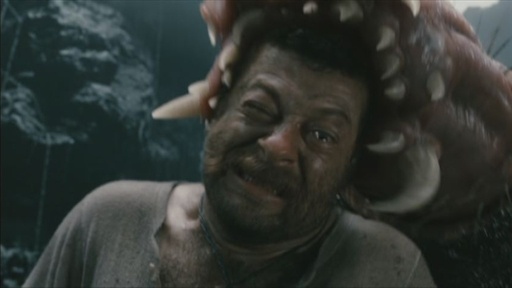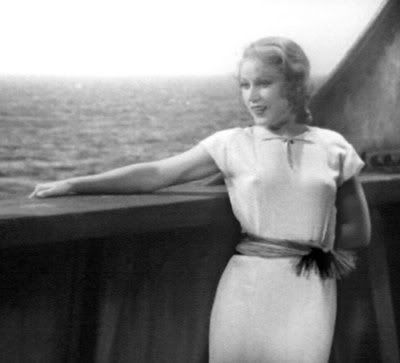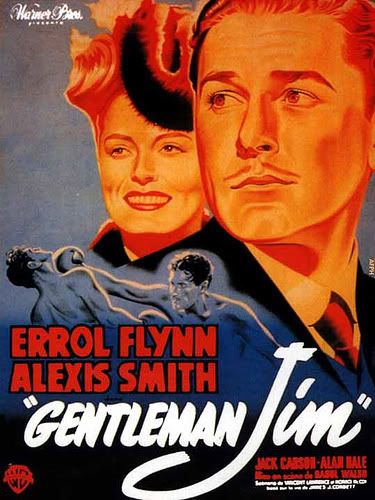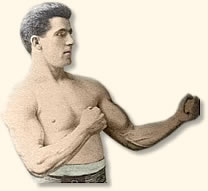King Kong (Peter Jackson, 2005)

I know we have a few MoFos who don't especially care for the newest
King Kong, but I'm a big fan of the film. Jackson found the right balance between crafting a loving homage to the 1933 original (his favorite film growing up) and retooling it for the CGI era. I admit that I'm usually not a fan of remakes, but I find this one to be the best version of the classic story. Although Jackson can be accused of making this
Kong "too-everything" (too long, too bloated, too much CGI, too much emotion, etc.), he does accomplish quite a bit in the way of suspense, action, spectacle and a believable Beauty and the Beast story with terrific performances as the couple by Naomi Watts and Andy Serkis, the latter aided by the effects team. Jackson's production designers also got to create the spectacular New York City of the '30s and the exotic, otherworldly Skull Island where Kong and the other huge creatures from the past still roam in the wild.


The film is basically divided into three parts. Part One (52 minutes) begins in Depression-era NYC where comic actress Ann Darrow (Watts) has just lost her gig and is contemplating going to work at the burlesque house to earn enough to eat. At the same time, movie producer/director Carl Denham (Jack Black) has just learned that the studio heads hate the rushes from his latest "wildlife" picture and are going to fire him, so, escorted by his assistant Preston (Colin Hanks), he gathers together what he can and hightails it towards the ship waiting to transport him across the ocean to the mysterious location where he wants to finish up his project without the studios' help. His primary problem is that he's lost his leading lady, and Fay Wray isn't available since she's off working with Merian C. Cooper. (A nice in-joke since Wray played Ann in the '33
King Kong and Cooper co-directed it. There are several such references throughout the film.) Luckily for Carl, he comes across Ann and entices her to join him when he mentions that his film is being scripted by playwright Jack Driscoll (Adrien Brody), an author with whom Ann would like to work. They get to the ship just before the studio execs and are introduced to Capt. Engelhorn (Thomas Kretschmann) and his crew which includes First Mate Hayes (Evan Parke), teenage former stowaway Jimmie (Jamie Bell) and Lumpy the cook (Serkis). Jack is also aboard ship, even if it originally isn't his idea. During the voyage, Denham gets plenty of footage with Ann and her leading man, prima donna Bruce Baxter (Kyle Chandler), but the captain isn't happy that he's sailing for an uncharted island, and then he learns that Denham has a warrant out for his arrest. Just when it looks like they'll divert to Singapore to hand Denham over to the authorities, the ship enters a fog bank and eventually reaches Skull Island.

All the supporting characters seem to have some back stories going on. For example, the Captain seems to be a very soft-spoken guy but you can tell that he's at sea hiding from some haunted past. However, the most affectimg relationship of the lesser characters is the father-son one between Hayes and Jimmie. Hayes is trying to teach Jimmie life lessons, and Jimmie has just begun reading Conrad's
Heart of Darkness, so their discussions of that book seem to be playing out in their true life adventure on the sea and at Skull Island. A relevant line is when Hayes tells Jimmie that the novel "isn't an adventure". After the setup and intro, Part Two (84 minutes) gets into the rock 'em, sock 'em action and creepy suspense, and this is where Jackson both pays faithful adulation to his fave film and deliberately tries to go into overdrive with a series of pumped action scenes which recreate but go well beyond the source. The original had one T. Rex; this one has three. [Note: Kong's battle with the three is both hilarious and has some startling 3-D looking shots, mostly involving the dinosaurs trying to eat Ann. I've heard some viewers complain that this fight scene is ludicrous and defies the laws of physics. Well, if you really think about that while watching a movie about a giant ape fighting three dinosaurs in 1933, then you probably shouldn't be watching this movie (and most fantasy) in the first place.] The original had one mad stampeding dinosaur; this one has dozens. The original had to cut out the gross-out scene with giant bugs and headsuckers; this one includes it using the original's storyboards.

The other thing which separates this
Kong from the original is the emotional empathy between Kong and Ann. In the original, Ann was terrified of Kong throughout the movie and showed no other emotions toward him. Kong was interested in the way Ann smelled. In fact, he pokes her with his finger a few times and then raises it to his nose to get a good smell of her. He's obviously fascinated with Ann, but she just wants to get away from the "Monster". In the 1976 remake, which was also updated to the '70s, Jessica Lange doesn't even play Ann. Instead, she plays Dwan and she's terrified initially by Kong, but later when they spend some quiet time alone and she finds Kong to be her protector against even worse beasts, Dwan even gets turned on by what Kong can do to her body! She does feel some love for Kong though, however it's nothing like the attachment which develops between this version's Ann and Kong. Eventually, Ann holds on tight to Kong when she sees that he's the one who can save her from Skull Island's scary fauna. She also introduces Kong to the concepts of humor and beauty. There is a deep, mutual bond between the two characters which I find totally natural, no matter how many times I've heard somebody call it weird or stupid. So, even if some find this movie redundant or a vulgar waste of money, I find it a good, old-fashioned entertainment, but with a lot more heart and soul than the other versions.

Dehnam and the crewmembers are able to capture Kong and take him back to NYC where he displays the Ape as the Eighth Wonder of the World. Denham is really depicted as a weasly guy who'd probably sell his mother to get a hit in the entertainment business. Jack turns out to be a decent heroic figure. [Note: the original
Kong has Jack Driscoll (
Bruce Cabot) as the First Mate on the ship who was a heroic figure and Ann's human love interest. This film seems to turn that character into three characters: Brody's playwright, Parke's first mate, and Chandler's vain actor who, not so coincidentally, is named
Bruce.] Part Three (40 minutes) is what happens when Kong is in NYC, leading up to the climax at the Empire State Building. We are witness to another array of spectacle and action made all the more fun by it occurring in a meticulously-recreated 1930's Times Square and environs. I don't think I need to go into any details about these scenes, but they don't disappoint me at all. Kong himself remains dignified right up to the very end.

I want to add that I grew up with the 1933
King Kong, and it was instrumental in my falling in love with the movies. The fact that you could see such things which were impossible has a big effect on a youngster. I think it's a classic and that everyone should watch it. My rating for it is
. However, I don't lionize it as others do. Willis O'Brien's stop-motion effects are incredible and a lot of fun, but the acting in the film isn't really A-quality. I mean, Fay Wray is beautiful and can scream with the best of them, but her co-stars aren't all that hot. Armstrong can play a big producer OK, but it's superficial, and Bruce Cabot is on the wooden side as the hero. Another thing is that the beginning is a little slow-moving. (Yes, I realize that many viewers complain that Part One of the 2005 version is slow and irrelevant, but I actually enjoyed the added time to get to know the characters. Even if many of the characters and their relationships don't "pay off" in the context of the plot, they do add depth and mystery to the film. I realize that some people today will just find the acting and FX of the original too hokey, but it's a real movie-movie, and I keep finding plenty of hokey acting and FX in today's films.


I'll even give the 1976 update a break and recommend that one too, at least until I see it again and perhaps change my mind. Although it's more sexually aware than the original, it actually isn't as sexy, but Jeff Bridges brings some seriousness to his role as an animal rights activist to help balance out Charles Grodin's broad, but amusing turn as a Snidely Whiplash-ish oil tycoon. Jessica Lange's screen debut is worth seeing even if the FX are laughably bad. So, all-in-all, a mixed bag, but still entertaining enough for me to give it a low
. I'll edit this if necessary upon a rewatch.














 ) is in the flick as one of the girls whom McCartney comes onto on the train.
) is in the flick as one of the girls whom McCartney comes onto on the train.  this movie
this movie 









